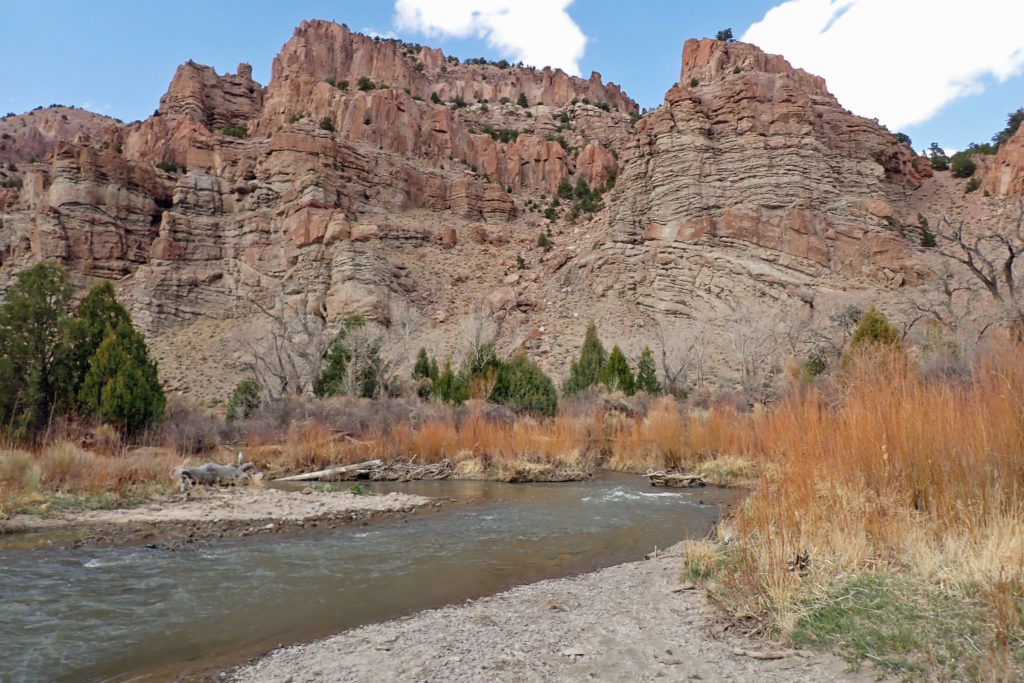
The Sevier River has always intrigued me as a Brown trout fishery, although I have never made any serious attempts to fish it. I recently decided to take the initial step towards changing that.
I was introduced to Utah’s trout waters in the late 1970s by my brother Neal. Our excursions included Pine Valley Reservoir northwest of St. George and a few of the reservoirs in the Tushar Mountains east of the city of Beaver. When I started working for EG&G Energy Measurements in 1981, my Audit Manager introduced me to Mammoth Creek and nearby Panguitch Lake. I often accompanied him to his cabin in the Yellow Pine area of Mammoth Creek, a major tributary of the Sevier River. It was a matter of time before Mammoth literally led me to the Sevier River. Although I cast a line in the Sevier with Neal once, I never seriously pursued it because my impression was that most of it ran through private ranch land, and access was confusing to me. The following amateur “snapshots” from the early 1980s will make the case for my intrigue.
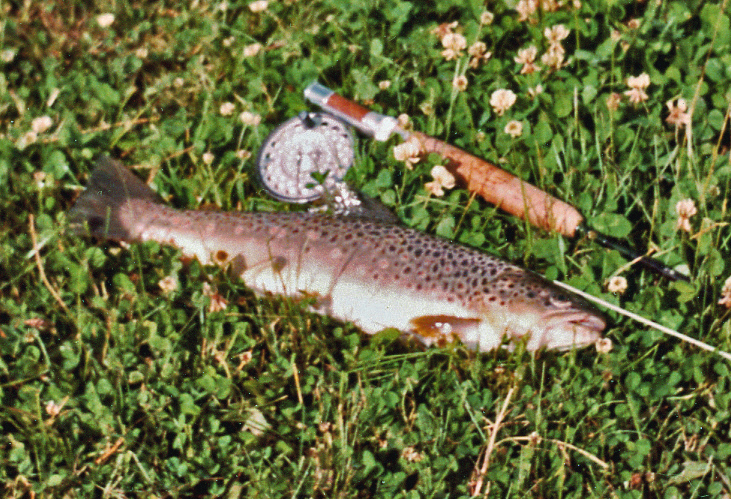
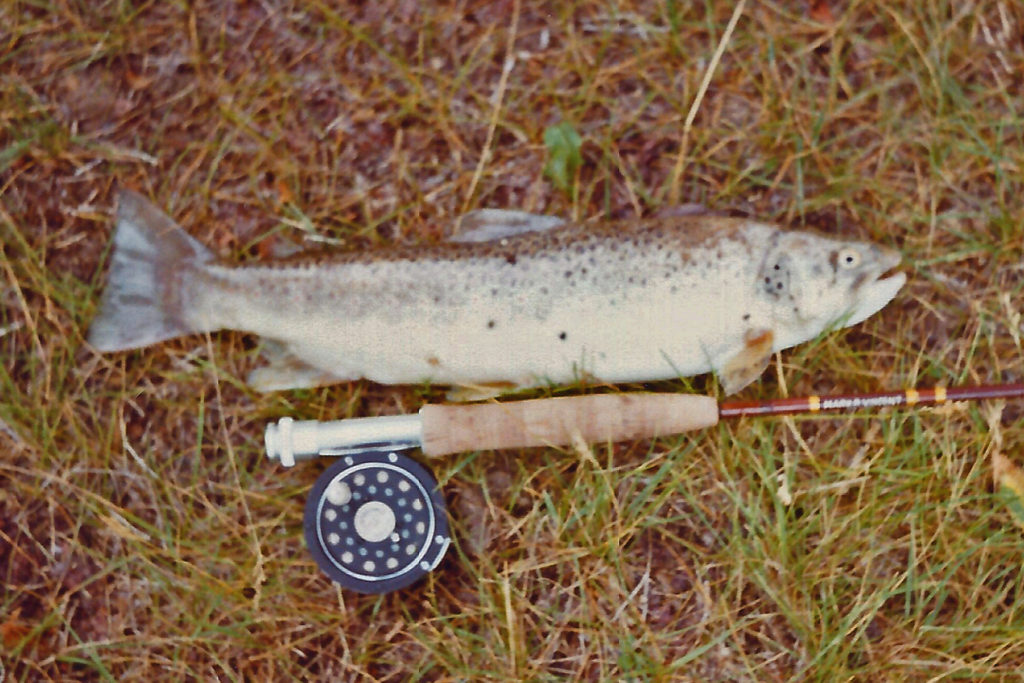
The Sevier River is the 5th longest river in Utah at 383 miles, right behind the Colorado, Green, Bear, and San Juan. However, its horseshoe shape in the center of Utah makes it the longest river contained entirely within the state. Its headwaters originate near Kolob Terrace in the forested Markagunt and Paunsaugunt Plateaus. In the wet seasons it might reach its terminal end, the intermittent Sevier Lake bed 40 miles southwest of the city of Delta, after flowing southwest across the Sevier Desert.
A few years back I began to read about the Kingston Canyon section of the East Fork of the Sevier River. East Fork joins the main branch of the Sevier near the town of Junction, which is about six miles north of the town of Circleville. Although small, Circleville is still twice as populated as Junction and has some amenities that Junction does not, maybe because of its perceived proximity to Bryce Canyon National Park.
The East Fork headwaters flow north through the town of Antimony, and then just below Otter Creek Reservoir it turns west-by-northwest to Junction. My discovery of the Circle Valley Anglers website is where I first learned of the Kingston Canyon section of the East Fork. Further research uncovered its Blue Ribbon status as a result of the restoration efforts by the UT Division of Wildlife Resources. All type of lures are allowed in this section, but upstream south of Antimony, in the Black Canyon, fishing is restricted to artificial flies and lures only from the Bureau of Land Management boundary – approximately four miles south of the town of Antimony – upstream to the confluence of Deer Creek.
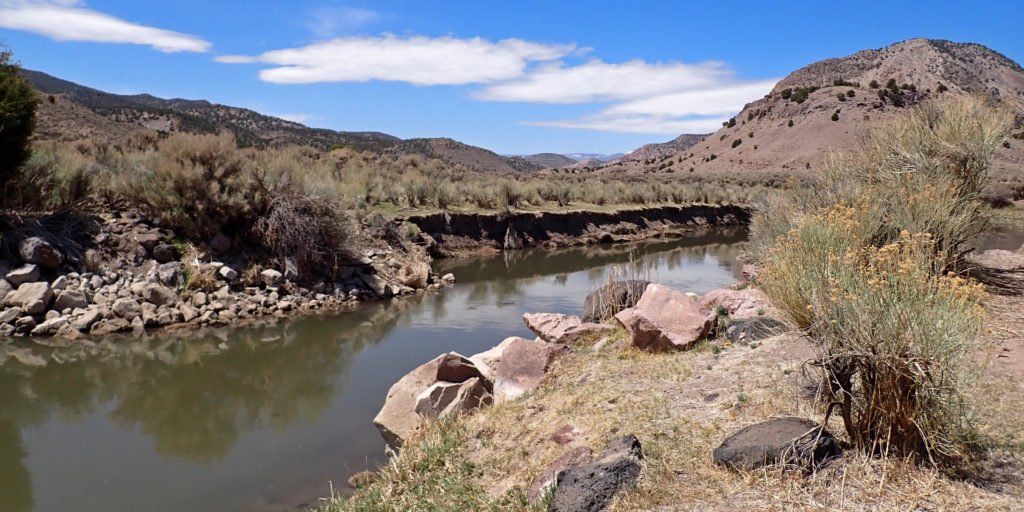
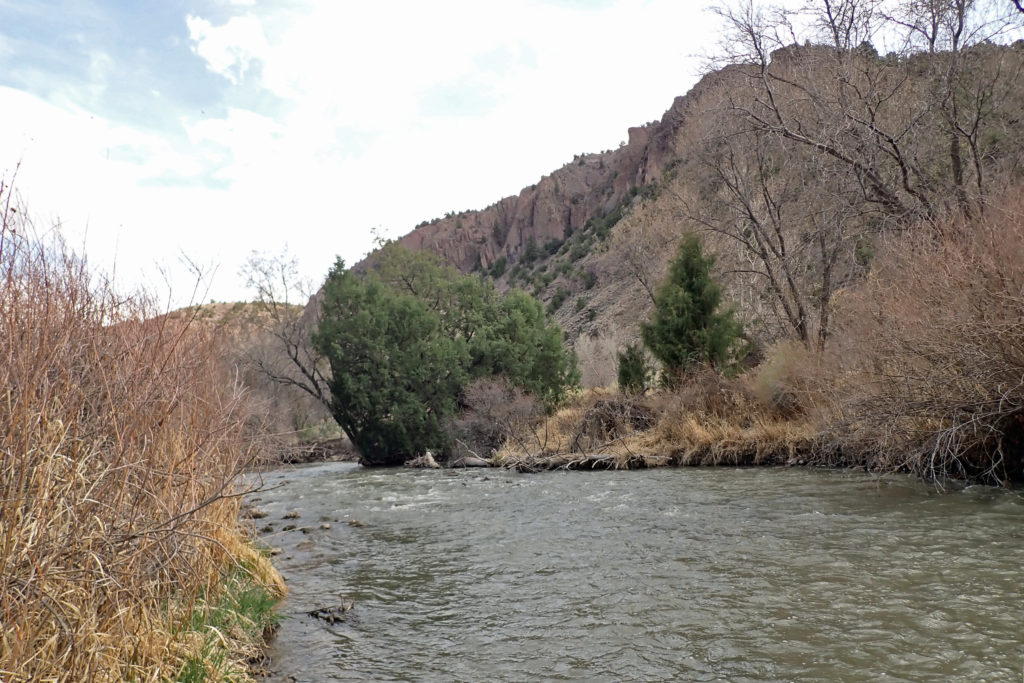
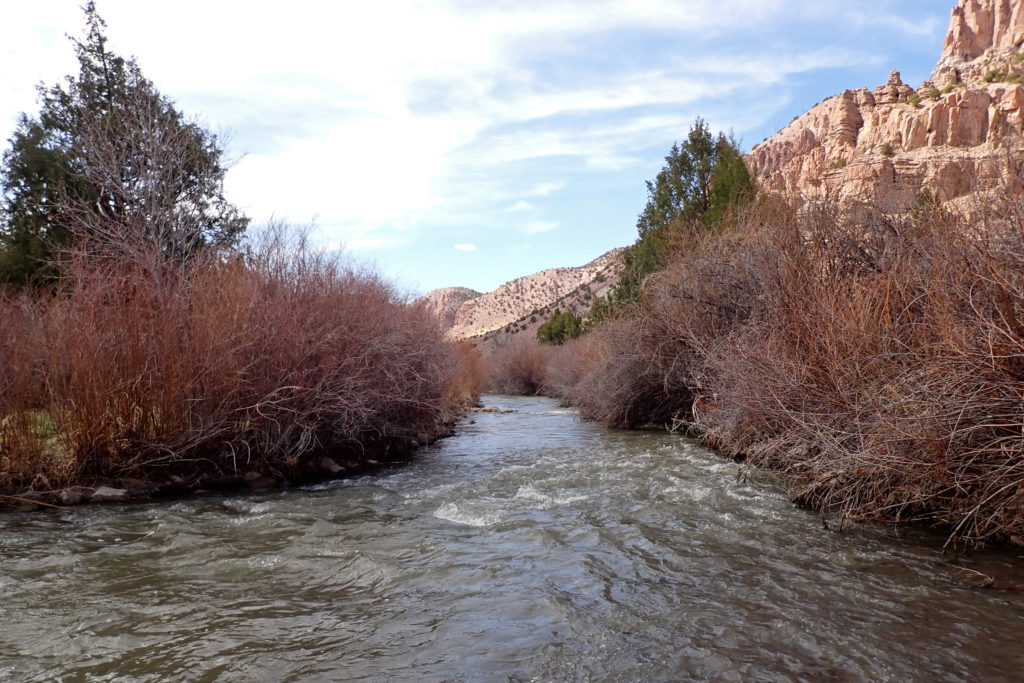
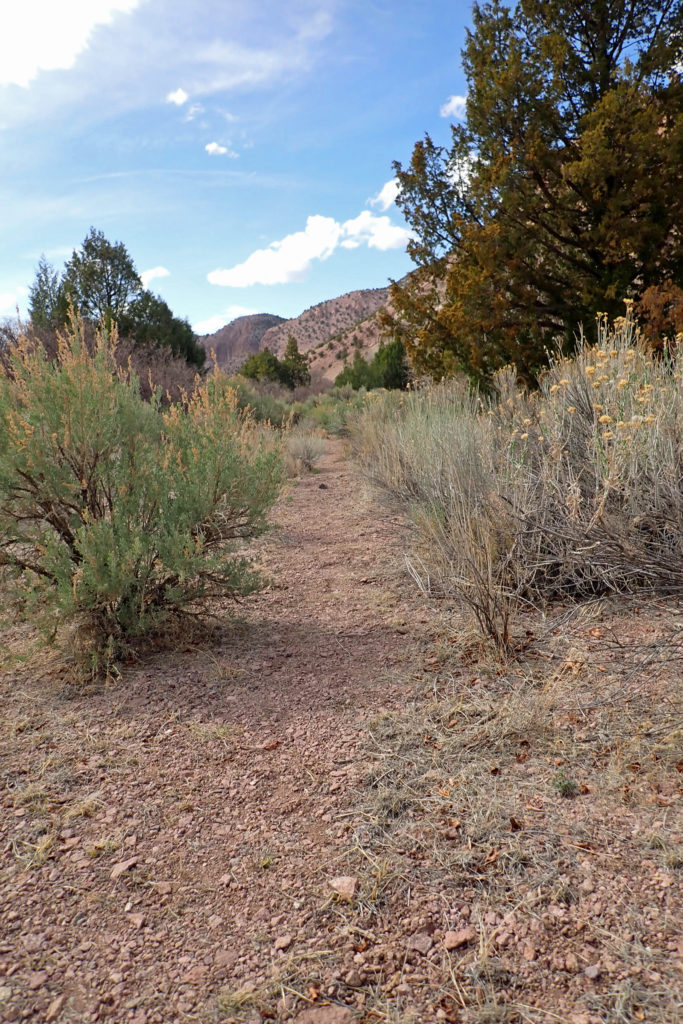
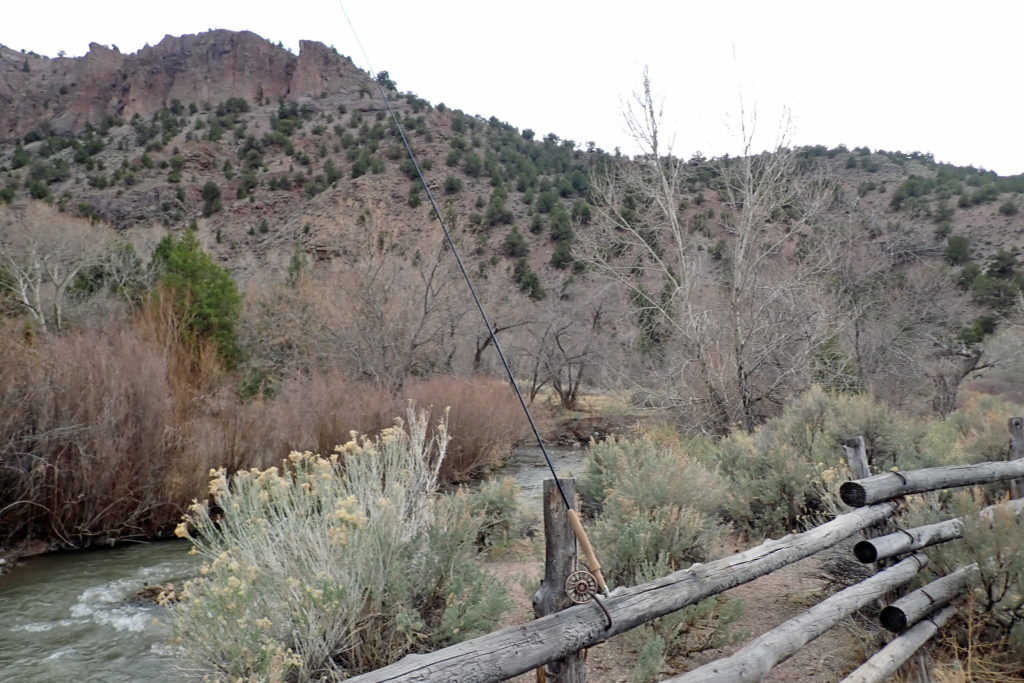
Despite my desire to learn more about angling for Browns in the Sevier, I did not spend more than four hours exploring and fishing Kingston Canyon. When fishing I was satisfied with my casting and drifting of the nymphs under the indicator. Often I had the telltale “ticking” of the indicator as the fly bounced along on the bottom river rock, so I was satisfied my nymph was being presented in the bottom of the water column where I thought the trout would be in the discolored water. Whenever the indicator stopped or was slightly pulled under I struck back, but the result was usually a snagged rock or limb; I lost about five or so flies which I think was expected under the conditions.
I would be lying if I said I was not somewhat disappointed that I failed to get at least one fish take, but at my age disappointment never lingers because there is simply too much to be thankful for in our glorious natural world. I was visiting beautiful country that was virgin to me, and there were other distractions in addition to the angling that became itches in need of scratching.
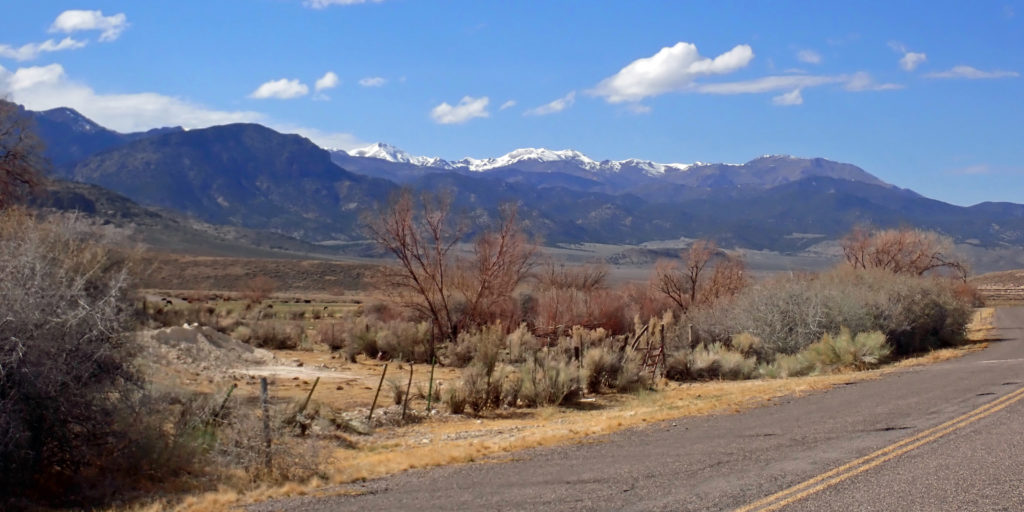
I mentioned fishing the reservoirs east of Beaver, UT in the Fishlake National Forrest (the Tushar Mountains). My first visit to Little Reservoir was with Neal when I was still doing my undergraduate studies. I returned to fish the daisy-chain of reservoirs on Kents Lake road (Forest Service Road 137, I believe) three additional times over the decades, twice with my sons. There are still reservoirs that I have not fished. Continuing up FSR 137 it terminates at Utah Route 153 at about 9,560 feet elevation (closed in the winters). At that junction you can turn left (where the road summits around 10,280 feet) towards Puffer Lake and Eagle Point Ski Resort (formerly Mount Holly) and eventually descend into Beaver, UT and Interstate 15, or turn right and descend into the town of Junction and US 89. It is a massive and regal mountain range.
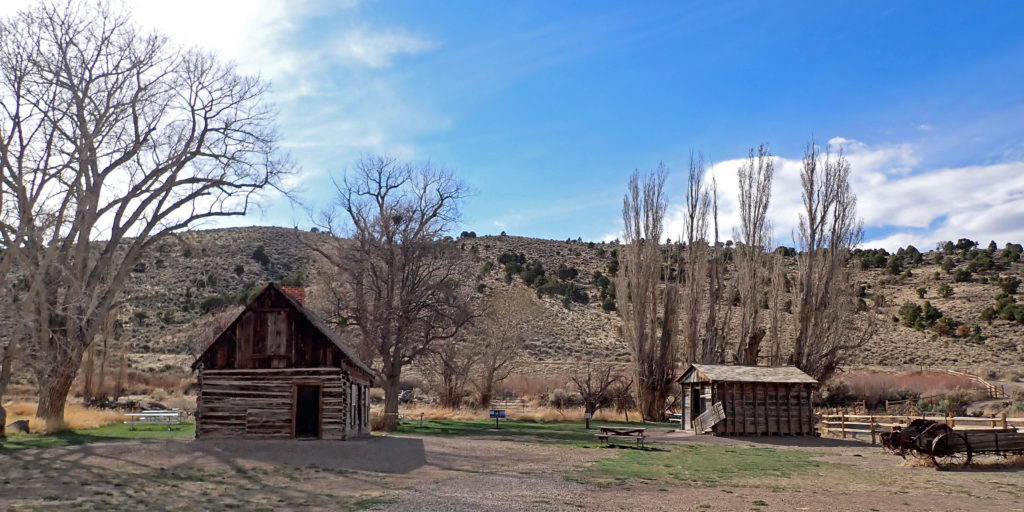
Most folks my age remember the 1969 western movie “Butch Cassidy and the Sundance Kid” starring Paul Newman as Butch and Robert Redford as Sundance. I suppose it was a semi-authentic representation of the most famous of the Wild Bunch outlaws around the turn of the 19th century, but some of Butch’s relatives claimed he lived for decades after the movie’s depiction of the legendary Bolivian shoot-out in South America. I bring up this movie because on US 89, a couple miles south of Circleville, UT, is a Utah State Park that honors the memory of Butch Cassidy (a.k.a., Robert Leroy Parker) by turning his teenage homestead into a museum and picnic grounds.
Now, stay with me as I try to connect Butch Cassidy to fly angling.
My other amusement with the 1969 movie is how it relates to Redford’s fascination with the mountains of Utah. He discovered an alpine area in the eastern slope of the Wasatch Mountains when riding his motorcycle from his home in California to college at the University of Colorado in the 1950s. He later married a girl from Provo, UT and returned to the mountain in 1961 to purchase two acres for $500 from the owners. Eventually he built a cabin there where he lived with his young family between his early film shoots.
By the late 1960s, developers were beginning to change the face of Utah. Fearing the worst from the developers, Redford managed to assemble enough money to buy another 3,000 acres, preventing a massive development of A‑frames that would have been built in the canyon. Ironically, he eventually developed the Sundance Mountain Resort, home to all sorts of events including the Sundance Film Festival. Apparently, development of the mountain was inevitable, and he wanted to control it.
The “Sundance” development connection to the movie is obvious. Redford made two other popular movies in the mountains of Utah: “Jeremiah Johnson” (1972) and “The Electric Horseman” (1979). And of course, although not filmed in Utah, in 1992 he produced, directed, and narrated the most iconic movie ever to popularize the sport of fly angling, almost to a spiritual level: “A River Runs Through It” which starred a young Brad Pitt. This semi-autobiographical novella recounts Norman Maclean’s life growing up in the valleys between the Rocky Mountains of western Montana in the early 1900s, and particularly his relationship with his brother Paul who was murdered at the age of 37, assumedly over gambling debts. Anyone who has struggled with a friend or family member who, while appreciating the gesture, rejected any offer to help them should read this book.
“Help,” he said, “is giving part of yourself to somebody who comes to accept it willingly and needs it badly.”
“So it is,” he said, using an old homiletic transition, “that we can seldom help anybody. Either we don’t know what part to give or maybe we don’t like to give any part of ourselves. Then, more often than not, the part that is needed is not wanted. And even more often, we do not have the part that is needed.”
A River Runs Through It, by Norman Maclean
My tongue-in-cheek theory about the impact of “A River Runs Through It” is that yuppies (i.e., young urban professionals) and dinks (i.e., dual income, no kids) who emerged from the decades preceding 1990 were in dire need of purpose. Pursuing nightclub dancing to disco and synthetic-pop music was carnal, not spiritual. They felt empty and unfulfilled, and so some turned to fly angling based on the spirituality the movie bestowed upon it. Redford and Pitt made it spiritually cool to seek the meaning of life while waving a bamboo stick in your hand. Truthfully, for me, the most important plot of this movie was about relationships, and the pain that comes from not knowing how to help those in your family who are most in need. Towards the end of the movie, which is fairly true to the book, in reference to his dead brother, Norman’s father says to him:
It is those we live with and love and should know who elude us.
Norman Maclean
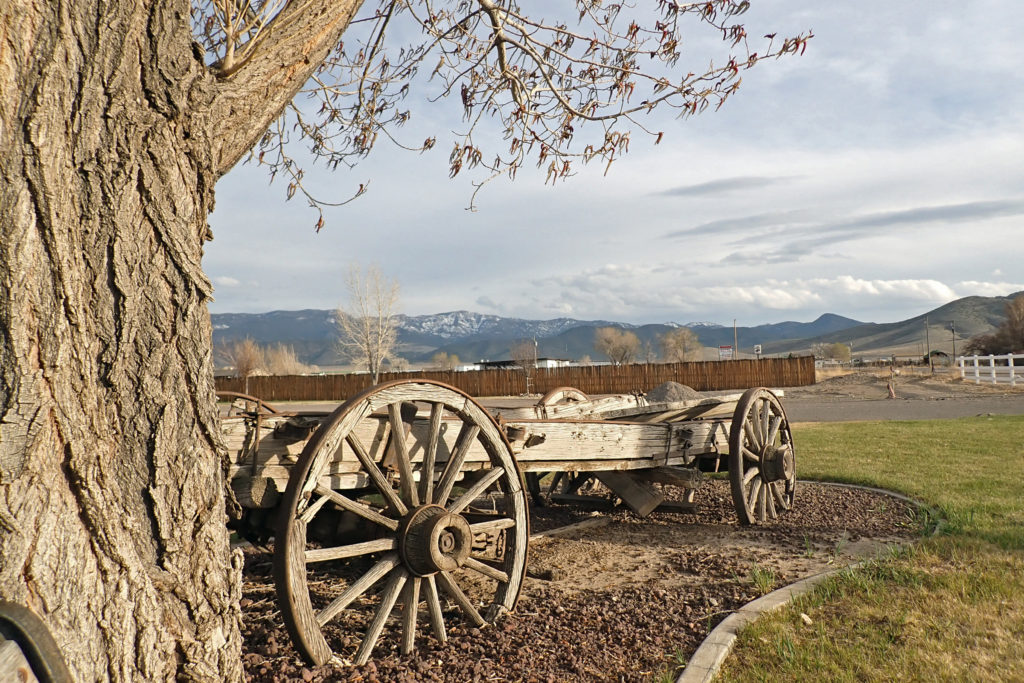
The morning after fishing East Fork, I decided to cross over the Markagunt Plateau starting from the town of Panguitch on UT 143. I drove by Panguitch Lake to check it out, and then took FH 050 to Yellow Pine. I had already decided to take FR 067 down to the Hatch meadow section of Mammoth Creek just to see what it looked like. My fly rod was still strung up, so I decided to spend 30 minutes swinging my nymph through the pools above and below the bridge. Although small, the Brown trout that took the nymph I was still drifting under the indicator was a partial remedy for the East Fork skunking. I still have very fond memories of Mammoth Creek, always will. I think if the Hatch Ranch allowed anglers to fish their section of the creek, I would be the first one willing to pay a sizable rod fee for catch and release angling.
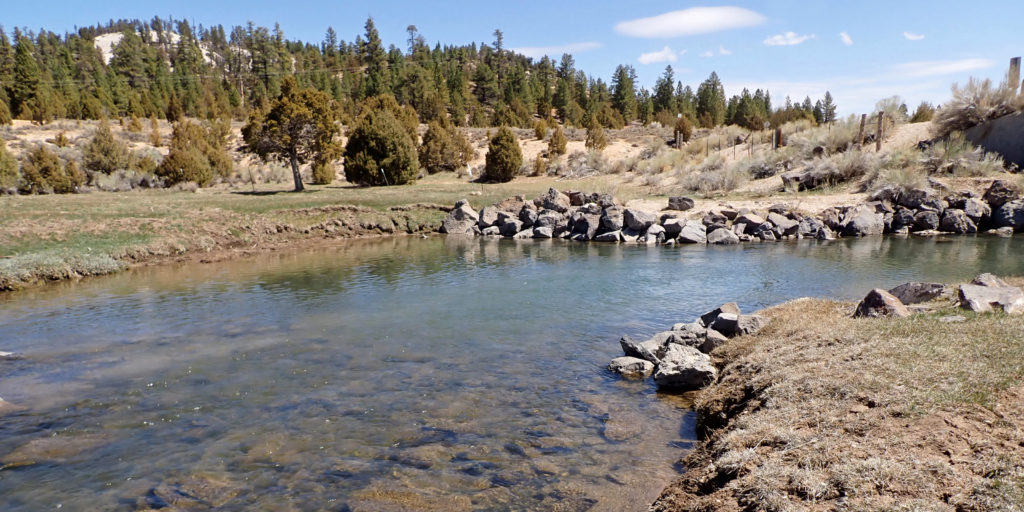
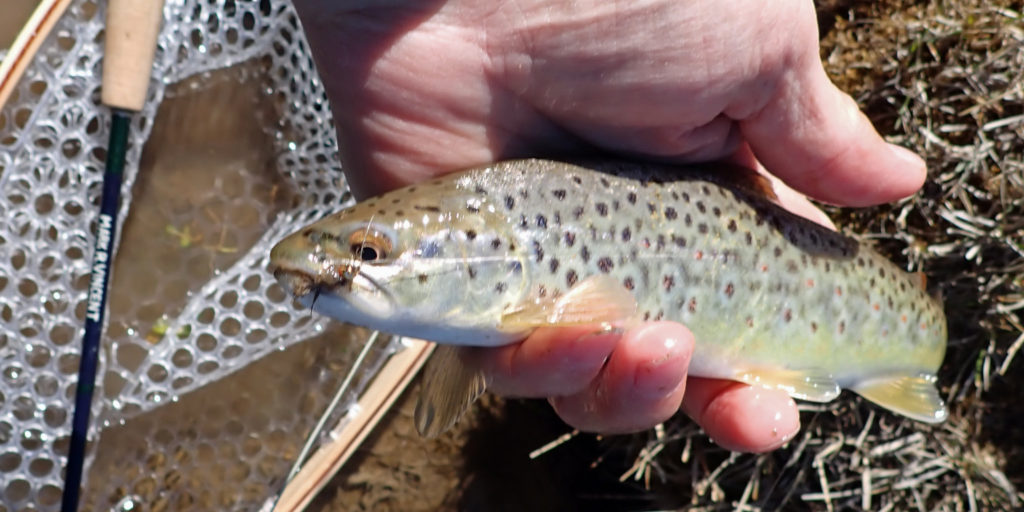
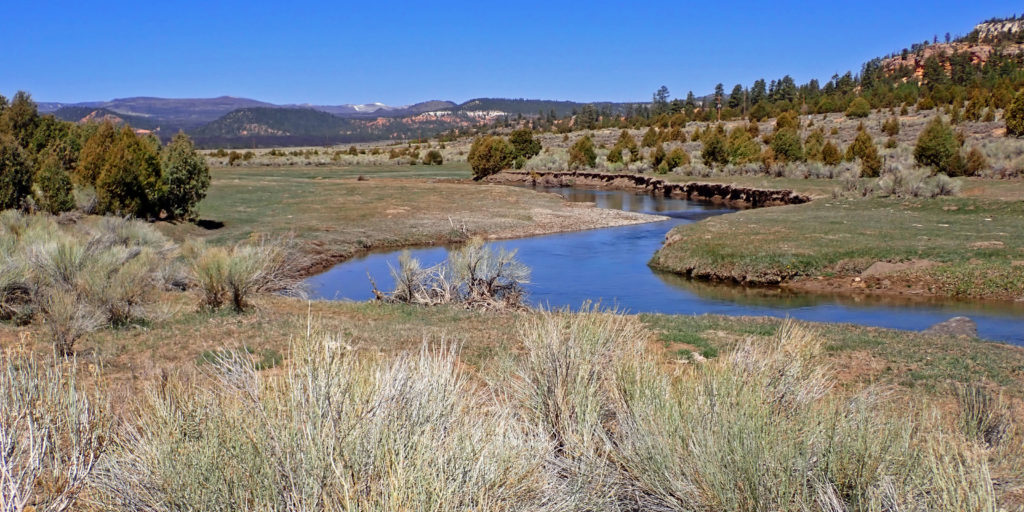
I broke down my fly rod for good, after which my backtracking up FR 067 to FH 050 was blessed with some notable mid-day wildlife sightings. About a half-mile above the bridge, three pronghorn antelope bucks trotted across the road and stopped about 100 yards away. One was still a youngster, but the other two had nice sets of horns. I noted how unusual it seamed for pronghorn to be up in the ponderosa pine at 7,500 feet elevation.
Another mile or two up FR 067, a large and healthy turkey hen crossed the road. She was about 50-percent larger than the pair I recently witnessed in Beaver Dam State Park near Caliente, NV, and she was a beautiful looking bird. Unfortunately, she did not stop for her glamor photos.
Not to be outdone, once back on FH 050 toward Duck Creek Village, there were two antelope does feeding next to the road in a meadow near the Mammoth Caves turn-off. By the time I got the camera ready they started trotting off, but I was able to capture their images anyway.
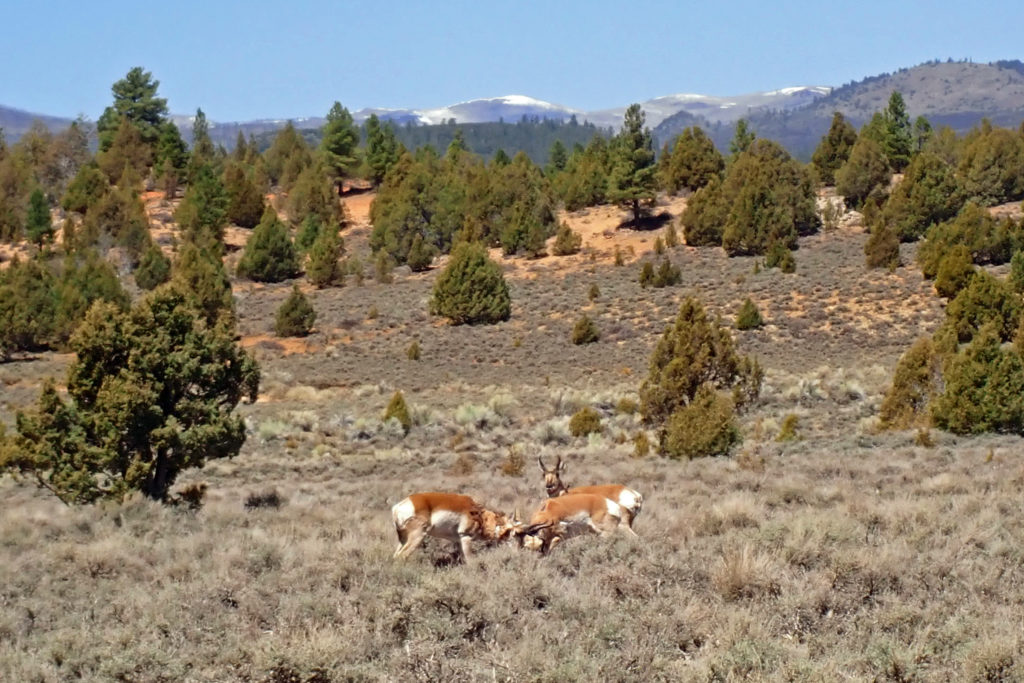
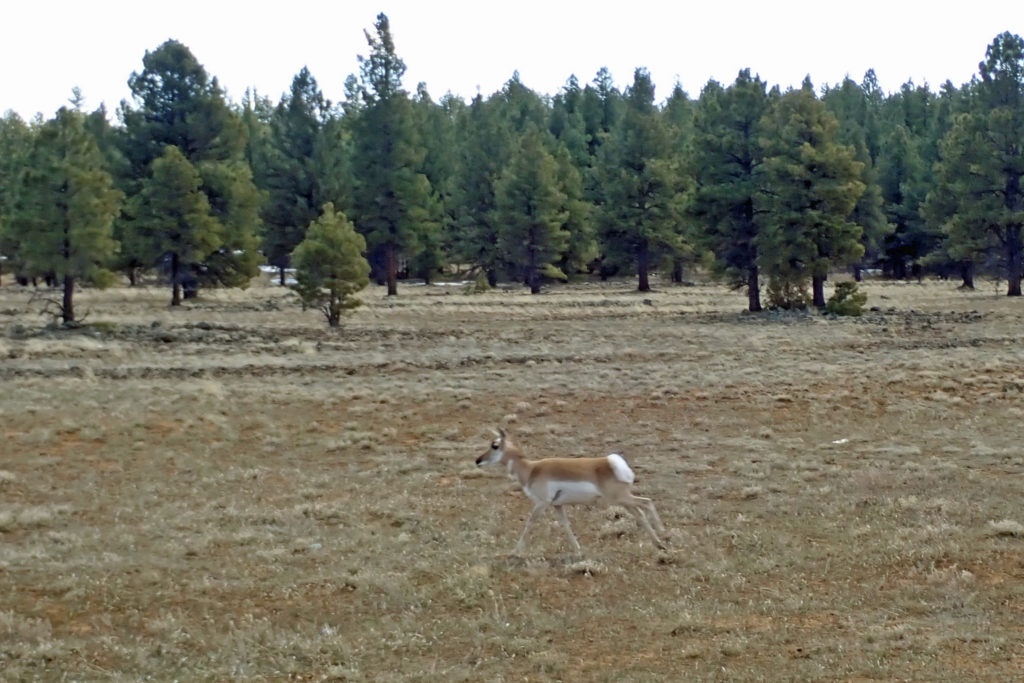
Please indulge me while I revisit this spiritual concept that I alluded to regarding Redford’s movie depiction of Macleans’s book. Most of us appreciate nature in all its forms. We marvel over its structure, complexity, composition, and palette of colors. Its bewildering variety of flora and fauna species mesmerize us. Heck, many of us are mesmerized just by exploring the plants and animals in our urban back yards. Anyone who has traveled North America, let alone the world, always gushes with amazement over the seemingly endless variety and beauty of our planet (which itself is but a speck in the universe).
We have created a plethora of outdoor hobbies just so we can be in nature. And it seems right that we enjoy the wonders of nature, after all it was created for us and we are its stewards. But, as Isaiah 45:9-12 clearly implies, we must not be foolish enough to worship the creation, rather we must worship the God who created it. As much as we celebrate nature through our outdoor hobbies, we should be giving thanks to the Lord. In Romans 1:19-20, Paul says one purpose of nature is to direct our attention to the Creator. The Lord deserves our praise and worship for his gift of nature. Nature does not deserve our worship, but because God gave us dominion over it we have a responsibility to care for it (Genesis 1:26).
To those unfamiliar with Jesus Christ and his Word revealed through the Bible, I would think you have some unanswered questions about god. Who or what is he? Did the god(s) create us, or are we simply a life form that evolved from… nothing (at present, scientists believe the stuff currently existing in the universe is dying a physical decay, so the origins of life remain a mystery with many unproven scientific theories on the beginning of life)? Are there multiple gods, like the ancient Greek gods inhabiting Mount Olympus? Is there an afterlife when we die, or does both our body and soul simply cease to exist? If there is an afterlife, is there anything required of us to attain it? Is there a “heaven” and a “hell” in the afterlife, some sort of reward or punishment depending upon our pre-afterlife thoughts and behavior?
There are indeed many questions that seem unanswered, and yet we live on lovely Earth with a thoughtful mind and a longing heart that questions: who am I, where did I come from, and where am I going? In short, what the heck is the meaning of my life?
If you are stirred to investigate further, here are some verses that might provide an answer or two, maybe a modicum of insight:
- Jesus declares only He is the path to eternal salvation: John 14:6 and Acts 4:11-12
- Jesus, the very word of God the Father, was sent by Him to redeem us from our sin: 1 John 3:23 and Matthew 17:5
- Rejection of Jesus is rejection of God the Father: 1 John 4:2-3 and John 5:23
- Rejection of Jesus will result in Judgement for our sin: 2 Thessalonians 1:7-9 and Luke 12:8-9
- Acceptance of Jesus brings His forgiveness: Romans 8:1 and Romans 5:15-17
- There will be evil “imposters” and “false prophets” that we need to reject: Galatians 1:8-9 and Matthew 7:15-20
- Jesus’s death and resurrection means that just being a good person alone cannot bring us salvation: Galatians 2:21 and Romans 8:8-9
- Jesus will be our ultimate judge: John 5:22-23 and 2 Timothy 4:1
Jesus said He came into this world to testify to the Truth. I pray you continue to pursue the truth.
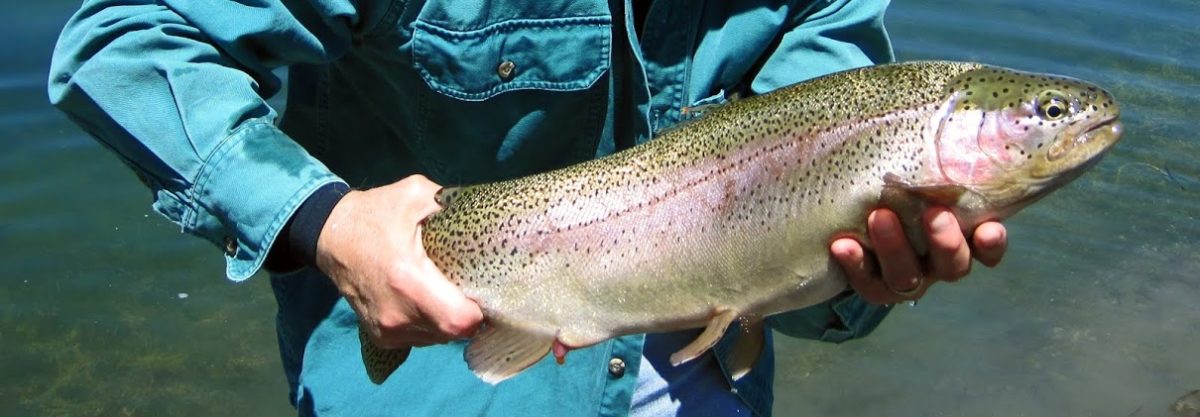
Waiting for retirement so I can take a trip with you so you can teach me.
Kirk –
That is a great idea. You have quite a bit of blue-ribbon trout water all along the eastern slope of the Sierras… I just don’t get up there often enough.
Love to you and the Gale tribe!
– Mark
Mark,
Please, please, please never stop your blog, I think that’s what’s it called…. Kelli and I love your adventures and we are planning on perusing those adventures!
Thanks Steve! I always appreciate your comments.
I mostly write for myself, with the hope that there might be one or two souls out there who feel and think similar to the way I do. I do hear from the occasional reader through email who really connects with the Christian aspect as well. We never know how the words we speak will impact those who are listening and are in need of help.
My best to you, Kelli, and the family. Miss working with you, too!
– Mark
I enjoyed reading about your adventure to Circleville, Utah and Kingston Canyon. I found it to be very interesting and enjoyable. Thanks for sharing.
Thank you Fred. Good to hear from you. Hope all is well with you!
– Mark
Great read Mark…it feels like a mini vacation when I read your blog! Thanks for the Gospel being threaded throughout! Blessings to the Vincent clan and all those who are reading this blog. Steve B.
Steve-
Thanks Steve. I’m happy you enjoyed it. Spread it wherever the HS moves you!
Love to you and Denise!
– Mark
I fished the EF of the Sevier River in Kingston Canyon about April 15th this year. I had several small trout follow the fly but no takers. I tried streamers and nymphs. I’ve only fished it a half dozen times in the past 5 years. I recall doing very well on it about half my outings including catching a 20 inch brown and a 20 inch sucker on a 1 weight on a warm February 18 (my birthday) a few years back. I had left my reel for my 5 wt rod back at the hotel in St. George so it was my 1 wt or nothing. Fortunately the cold water and experience allowed me to land those 2 plus quite a few others that day. The water is very low this year. Not sure where the bigger fish were hanging out. It’s worth a revisit in the summer or fall.
Thank you, Paul, for sharing your experiences on the East Fork. Hearing another angler’s stories always provides encouragement (and the 20″ brown on a one-weight… how cool that had to be!). I chuckled about leaving your five-weight in the hotel. It sounded familiar to me. I once left my Galvin reel spooled with five-weight at home (took my small reel bag instead of my large reel bag with my five and seven-weights), so I married up my four-weight reel with my five-weight rod (which worked fine, as you might expect… certainly not as if I had to cast a one-weight on the five-weight rod, or worse the other way around). You have given me, and other anglers, hope for our own “cool” revisit to the East Fork.
All my best to you.
Mark
Thanks for sharing your recent adventure in Utah. I enjoyed your telling of the details almost like I was there. Glad you were able to get out and about a bit to do some exploring.
Peace be the Journey Brother!
D
Hey David! So glad you posted a comment. You would have liked this trip. We’ll have to plan another trip together.
Hope you found it easier to post comments on this new WordPress format.
All my best to you and the family.
Been fishing these areas many times. Can be some of the best fishing anywhere. As a matter of fact I am going there in a couple of days. For a week of fishing
For several reasons, other than Mammoth Creek I never never really explored other creeks in southern Utah. I had hoped to get back to Kingston last fall, but didn’t. There is some very good water over there holding very respectable fish… I just have to invest some time.
Thank you for the post. May I ask, are you any relation to Tom Perrigo in Las Vegas?
All the best on you trip!
I hit Kingston Canyon today. Water was a little murky, but managed to land a sucker and a beautiful Brown Trout. It’s always awesome to get out into nature!
Nate,
Sounds like an awesome trip to the Sevier. Congrats on your success in the Kingston Canyon. Looking forward to hearing more of your angling exploits as you get to know the nearby Utah and Nevada mountain streams.
All the best to you…
Mark